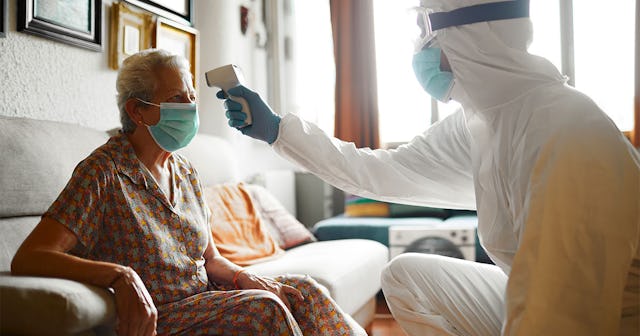Nursing Homes Are (Still) COVID-19 Hotspots, But The Facilities Aren't The Problem

It’s been eight long months since the COVID crisis hit the United States, and due to a lack of governmental oversight, there is seemingly no end in sight. Numbers across the country are exploding. Schools, cities, and entire states are facing tightened restrictions and complete shutdowns, and families remain socially distanced. For many (ahem, see also: responsible-ass adults) Thanksgiving and Christmas will take place over Zoom. And while no one — or place — is immune to this illness, one population remains particularly at-risk: those living in nursing homes.
In fact, according to a recent report, nursing homes are seeing a record number of new COVID cases.
The data, released by Johns Hopkins University and the Centers for Medicare & Medicaid Services (CMS), represents more than 14,000 nursing homes and assisted living communities. And while the report shows a marked increase in cases across the country, Midwestern communities have been particularly hard hit. During the first week of November, nearly half of all new COVID cases in nursing homes came from Midwest states. As a result, the Midwest region has seen a 200 percent increase in weekly COVID cases in nursing homes since September.
Of course, the increase isn’t a surprise. Nursing homes have been COVID hotspots for some time. In fact, nursing homes and assisted living facilities were one of the first epicenters of the virus. Plus, rates are rising around the globe; we’re smack in the middle of the “second wave.” However, nursing homes aren’t to blame. According to Tamara Konetzka, a nationally recognized expert on long-term care at the University of Chicago, community spread is a top factor in outbreaks in nursing homes.
Jeremy Poland/Getty
“Trying to protect nursing home residents without controlling community spread is a losing battle,” Konetzka says — and Dr. David Grabowski, a professor of health care policy at Harvard Medical School, agrees. “The strongest predictor of whether or not we’ll see cases in [a particular setting] is community spread,” he told The Washington Post.
The report also showed COVID-related deaths in nursing homes have risen, albeit slightly. Approximately 1,400 people died due to COVID-related complications last week. And while this rate is still lower than it was in the spring, experts are worried that the rising number of new COVID cases will ultimately lead to an increasing number of deaths.
“Our worst fears have come true as COVID runs rampant among the general population, and long term care facilities are powerless to fully prevent it from entering due to its asymptomatic and pre-symptomatic spread,” Mark Parkinson, the president and CEO of the American Health Care Association and National Center for Assisted Living, said in a statement. “Our health care heroes are doing everything they can to prevent it from spreading further, but this level of COVID nationwide puts serious strain on our workforce, supplies, and testing capacity.”
FG Trade/Getty
He goes on to emphasize that with Thanksgiving around the corner, things are only going to get worse if people congregate and celebrate like it’s still 2019: “The public must realize that their actions not only endanger our nation’s most vulnerable, but also trigger government lockdowns of facilities, keeping these residents from their loved ones. This is detrimental to their health, wellbeing and happiness. We urge everyone to do their part to slow the spread immediately and exercise caution when celebrating Thanksgiving.”
The American Health Care Association and the National Center For Assisted Living recently released a list of actions that Congress needs to take during their lame duck session in order to combat the virus – among them, financial help with the costs of testing, staff, and proper PPE. It remains to be seen, of course, whether Congress will prioritize these long term care facilities and their residents by passing another COVID relief package.
So what can be done? More importantly, what can we do? Until a vaccine is available, the only way to prevent new COVID cases from forming is to slow the spread of the disease. Masks should be worn at all times, regardless of where you live and what your community or municipality deems. Social distancing protocols should be adhered to — i.e. keep others at a Christmas tree’s-length. Unnecessary travel should be avoided. Seriously. You should probably just cancel that Disney trip now, and don’t go to large gatherings or dinner parties. (Sorry, Aunt Suzy, but it’s the truth.)
It is inconvenient? Yes. Lonely? For sure. But lots of grandparents — your own included — will thank you.
Information about COVID-19 is rapidly changing, and Scary Mommy is committed to providing the most recent data in our coverage. With news being updated so frequently, some of the information in this story may have changed after publication. For this reason, we are encouraging readers to use online resources from local public health departments, the Centers for Disease Control, and the World Health Organization to remain as informed as possible.
This article was originally published on